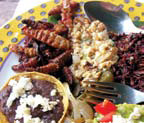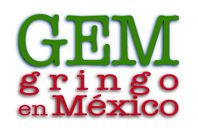
|  |  |  Entertainment | Restaurants & Dining | March 2009 Entertainment | Restaurants & Dining | March 2009  
Incredible Edible Insects
 Robert Alexander - Gringo En Mexico Robert Alexander - Gringo En Mexico

If you’ve seen my TV show on Unicable, “GEM – Gringo En Mexico,” you know that I climb up rocks, rappel back down them, and ride cables over wide canyons. But I also do something a little more wild than that: I eat insects for a living!

Now, don’t leave the page! Almost 80 percent of the world’s population is entomophagous.

That’s the adjective. An entomophage (the noun) is an organism that feeds on insects.

The UN Food and Agriculture Organization (FAO) estimates that about 1,400 species of insects and worms are eaten in almost ninety countries in Africa, Latin America, and Asia. Insects are also a good source of proteins, vitamins, and minerals.

Did you know that one hundred grams of beef contains 54 to 57 percent protein, while one hundred grams of crickets contains between 62 and 75 percent protein? A couple of months ago, I filmed an episode of GEM at the Pre-Hispanic Gastronomic Fair at Santiago de Anaya, Hidalgo, where I ate four kinds of insects. There were stewed stinkbugs, fried crickets, maguey “worms” (gusanos, actually a type of caterpillar) and ant “eggs” (escamoles).


| | Yummy... Gusanos de maguey and escamoles |
Let’s talk about gusanos and escamoles; they’re my favorites. If you’ve spent any time in Mexico, you’ve probably seen the maguey cactus: it’s practically the national plant. You can harvest the maguey “worms” from the beginning of the rainy season in the spring until late autumn. Their taste is a mixture of bacon and peanut butter—how’s that for a combo!

The preparation of these delicious “worms” is fast and simple. Give them a good wash and dry. Then, fry them in hot oil, add salt, supply warm tortillas, salsa, and get out of the way! Your Mexican friends will make them disappear while you’re politely getting in line for a turn. Escamoles are the larvae of ants of the Liometopum genus, and are gathered from between the underground roots of various Mexican cacti.

These “eggs” are about the size of beans and are referred to locally as caviar. They are rich in fats and taste something like nutty cottage cheese. I prepare these “eggs” by, again, washing and drying them thoroughly, and then sautéing minced onion in butter and throwing in all I can afford just before service: escamoles cost about the same as Beluga. Offering them to your guests in a clay casserole with warm tortillas and salsa will make them appear all the more tempting.

I think most of us have been exposed to chocolate covered ants at sometime during our childhood, but have you ever eaten a scorpion? It’s easy to do. Cut off the stinger and deadly poison gland at the end of the tail, dip the bug in your favorite spiced egg wash, and fry until crispy. You should end up with something like a battered shrimp.

Now, don’t throw down Inside México and your morning coffee and start eating bugs from the kitchen floor! Urban insects can be contaminated with animal waste, parasites, and insecticides. However, with over 1,400 insect species eaten by humans (entomophages) worldwide, the insect world offers commercial and nutritional advantages to the first, second, and third world.
 
Most edible insects are, in fact, harvested from forests and agricultural fields. They account for the greatest biodiversity in the animal kingdom and are the least studied of all fauna. You can find maguey “worms” and ant “eggs” at markets in rural areas. You might also find them prepared at upper end Mexican restaurants in your neighborhood.

Reprinted from Inside Mexico's September 2008 issue |

 |
|  |



